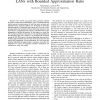34 search results - page 6 / 7 » On the Extension of Bipartite to Parity Graphs |
TMM
2010
13 years 2 months ago
2010
With the exponential growth of Web 2.0 applications, tags have been used extensively to describe the image contents on the Web. Due to the noisy and sparse nature in the human gene...
BMCBI
2010
13 years 7 months ago
2010
Background: Extensive and automated data integration in bioinformatics facilitates the construction of large, complex biological networks. However, the challenge lies in the inter...
AI
2007
Springer
13 years 7 months ago
2007
Springer
One difficulty that arises in abstract argument systems is that many natural questions regarding argument acceptability are, in general, computationally intractable having been c...
CORR
2010
Springer
13 years 6 months ago
2010
Springer
We consider an extension of the popular matching problem in this paper. The input to the popular matching problem is a bipartite graph G = (A ∪ B, E), where A is a set of people,...
ICCCN
2008
IEEE
14 years 1 months ago
2008
IEEE
— The current access point (AP) association schemes in wireless LANs, such as IEEE 802.11, cause an unbalanced load which reduces the performance of both the entire network and i...

